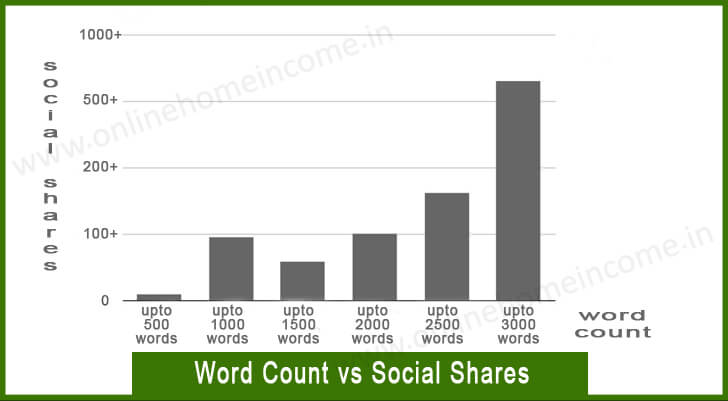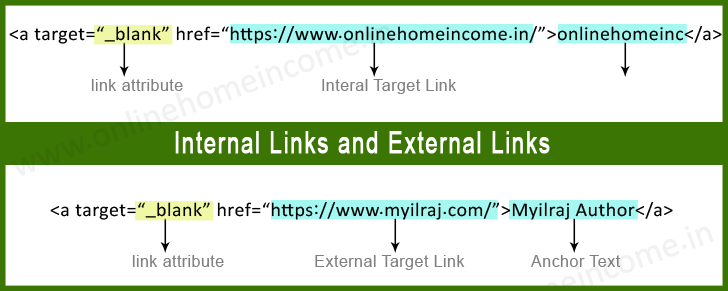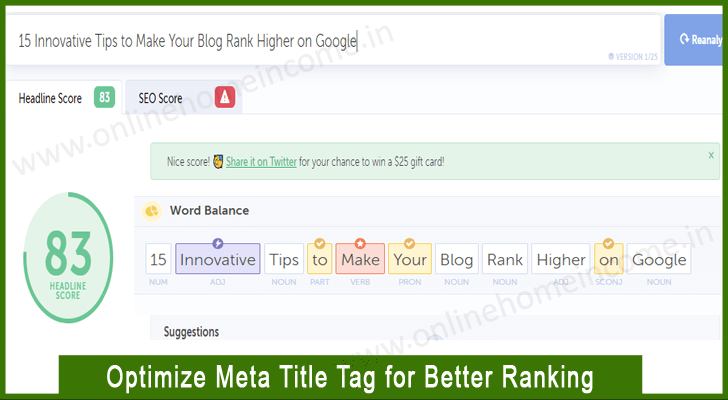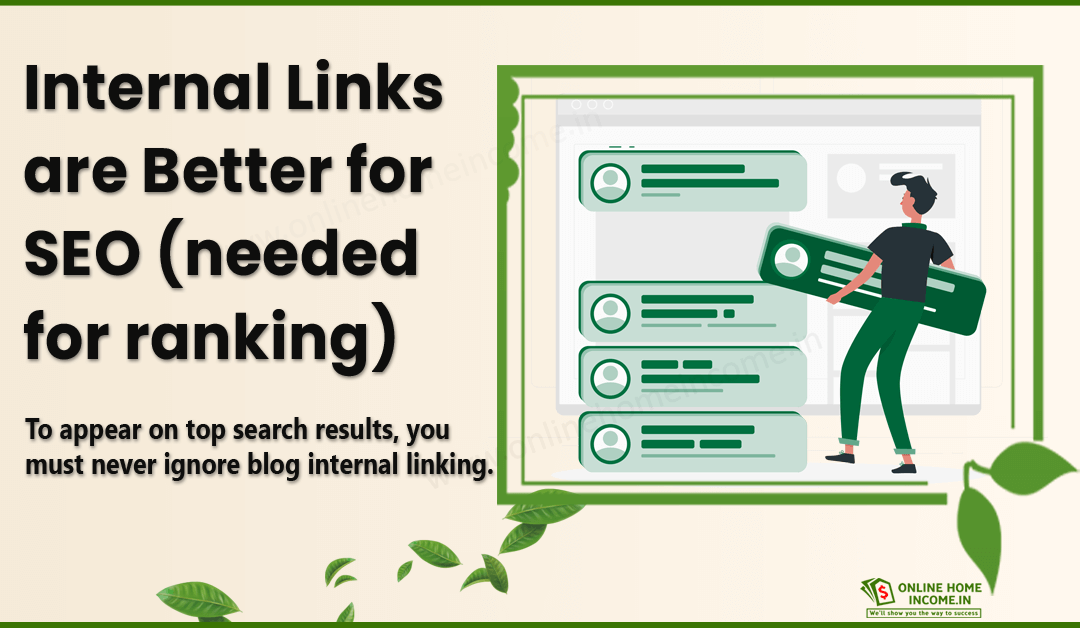In this article, I will share some practical tips on how to make your blog rank higher on Google. Some bloggers may have already been implemented, and a few don’t know what to do. If you are the few, here is the solution.
Driving Traffic is the most crucial part of success in blogging. Did you remember when did you search — How to make your blog rank higher on Google?
More than 80% of bloggers are worrying about their blog traffic. They are under pressure and need to find a way to rank their blog posts.
Are you frustrated after seeing fewer (or no) views and engagement on your blog posts? Are you stuck in finding the right way to rank in Google?
Newbie bloggers are taught to produce a large number of articles by spending extra time. Hence, budding bloggers forget that blog marketing is essential to drive visitors and generate passive revenue.

Bloggers keep searching for different methods to push their blog posts to Google’s first page. If you are the one who is searching for a similar solution, then read this article.
You all know that blogging is the most successful business suitable for all people. It starts with proper keyword research, followed by writing SEO-friendly articles.
Then you have to integrate various digital marketing strategies to drive potential visitors.
Search Engine Optimization (SEO) is crucial to increase your blog visibility and ranking it higher on Google.
Unless you rank for keywords, no one knows about you and therefore no traffic. When no one visits your blog, who will click ads (or) buy products you recommend? Stop worrying and start practicing these best methods to improve your Google rankings fast.
How Can I See My Blog Post Ranking?
A blogger can check the blog post ranking in Google and other search engines using several ways. Bloggers should often keep an eye on their blog post ranking (you should check regularly).
Beginner bloggers manually check the ranking position of their blog posts on Google by typing the keywords.
It is not usually suggested as you will not get a clear vision of the exact ranking position.
Instead, you can use SEO tools like SEMRUSH, Ahrefs, and Google Search Console.
I always prefer using Google Search Console to check my blog rankings and record them on an excel sheet.
It is included in my weekly SEO activity on all blogs (including my personal blog and my student’s blog).
Monitoring the performance at regular periods helps you plan new strategies and improve the existing work portfolio.
Other important metrics to monitor
- New users vs repeated users (when more new people visit your blog shows that you are growing)
Pageviews. - Traffic source (Organic, Direct, Social, and Referral).
- Visitors’ time on your blog (Bounce rate or engagement).
These are the fundamental metrics that I record every week.
Regular monitoring of your blog ranking makes you stay aware of your blog health. Reports help you make progressive decisions and create strategic plans to improve your blog ranking over time.
15 Tips to Make Your Blog Rank Higher on Google
Several studies say that Google wants a new blog or a website to wait for 3-4 months. Till then, Google bots visit your site to study the structure and hierarchy.
Normally, it will take 4 – 6 months for Google to rank a blog for the keywords. The duration depends on the industry, competition, and keyword popularity.
Reaching the first few positions on the search engine result pages does not happen overnight.
The blogging industry is becoming highly competitive these days as more people venture into this business.
Defining the time for ranking a blog or blog post on Google is not a science or math to derive an exact answer.
As many factors influence the ranking, it will take time to figure out the bottlenecks before finding a solution.
In this post, I have shared some of the 15 best tips to help you in ranking your blog.
1. Write on the Topic that Interests You (and Your Audience)
The very first step in how to make your blog rank higher on Google is to research the topics that are in demand.
Of course, blogging is about writing helpful articles of your interest. Writing based on interest does not mean that others must like your content.
You must do some research on the following terms;
- Is the blog topic sounds interesting?
- How many people are searching for the topic daily?
- Who is the target audience?
- What is the future scope?
Answer the above questions before choosing the right topic for blogging.
And, how do you find interesting and interested topics?
- My first go-to platform is Google-related search and more keyword suggestion features. Here’s where my most keyword research starts with.
- I prefer a few keyword research tools like Google keyword planner, Ahrefs and SEMRUSH.
- Next, I go to Quora to get some content creation ideas on the selected topic. It is the best content-sourcing platform for my blogging career.
Quora helps me to get the common problems, bottlenecks, and growth ideas on the topic. This knowledge makes me create outstanding content for my blogs.
2. Add Keywords Naturally to Educate Search Engines
So, now you have the topic ideas prepared after long research. The next part is to start finding the keywords.
Do you know how the search engine works? It is a software program created to provide relevant results based on user input.
Google is the best example and the most widely used search engine.
Here, the user input is referred to as Keywords. It is another big topic, and I advise you to read — how to use keywords in blog posts to make your blog rank higher on Google.
Proper keyword research and usage are essential to help Search Engines understand your blog content quickly.
If your article can educate a search engine bot, you can easily rank higher on Google for the keywords.
Here are a few tips on adding keywords naturally in the articles.
- Use the focus keywords once in the Meta-title, Page title (or) H1, Meta-description, and Image name and alt-tag.
- Add the secondary keywords in the Meta-description, sub-headings, and once every 250 words.
- Include the focus keywords in the first 100 words and the last 100 words of the blog post.
- Ensure the keyword placements look natural, and they should not be intended for manipulating the ranking.
Adding relevant keywords in the various places of the blog post help Google to crawl and understand your content.
Keywords help Google to evaluate the content’s relevancy to the search query. The more you make the process easier – the more rankings you can get.
3. Create Long Content by Adding Detailed Information

Many studies proved the fact that long content is considered a valuable asset by Google. On average, most bloggers begin publishing long blog posts consistently.
Based on the topic and the keyword selection, do detailed research to collect more information and data.
Start writing the blog post explaining every sub-part in detail by adding valuable information and supporting data.
Writing long articles gives you long-term benefits in terms of SEO. It will also make other bloggers link to those long in-depth content.
It will take more time to write, but it’s worth it. I advise you read an article on How long should a blog post be in 2022?
Here is the summary of the article:
- Long articles increase engagement (average user time on site) and improve organic ranking.
- Lengthy blog posts get more social shares and backlinks from other blogs.
Are you worried about why blog posts are not ranking on Google? Start writing interesting and engaging articles of a minimum of 2000+ words covering the topic in detail.
4. Page Speed is an Important Ranking Metric
We are in the age of digital media, where people want quick information and results. Technologies here are to create and push the available information as fast as possible.
Hence, check your blog loading speed. If your blog takes more than -2- secs, you are in danger of losing your ranking position.
Google is continuously altering its algorithm to rank websites based on speed.
Do you know about the Google Core Web Vitals update in May 2020?
Google announced that page speed is an important ranking signal that measures the speed, responsiveness, and visual stability of web pages. From then, Google launched many updates to improve the user experience (speed and responsiveness).

Use tools like GTMetrix, Webpagetest(.)org, and Google page speed insights to test the speed often. I check my blog loading speed twice every week.
If you are not able to improve your blog speed (or) don’t know how to work around – book a consultation call, and we will discuss it.
If you are using the WordPress platform, you can install a few speed optimization plugins like WP-Rocket, W3TC, LiteSpeed Cache Plugin, etc.
5. Optimize Images (Image SEO)
A single image can speak 1000 words — do you remember these words? Adding appropriate images inside the content helps you to make your blog rank higher on Google.
In WordPress, you may often come across the term – featured image. It shows how important it is to add images to your content.
People feel bored reading such long articles. Break long content by inserting relevant images to create interest among your readers.

Don’t forget the Image SEO.
- It means adding a proper image name and alt text incorporating the target keywords.
- Before you upload the image to your blog post, change the filename with the proper keywords.
After uploading it to the media folder of your WordPress installation, add Alt text. It is a brief description that describes what is there in the image.
6. Increase Dwell Time and Reduce Bounce Rate
Do you ever hear the term – Dwell time? It is the term referred to as the time that counts from the moment a user clicks your link in the SERP pages and returns back.
Google starts measuring this time gap to evaluate your ranking position.
- Increase the dwell time by creating captivating content and adding images, videos, quizzes, stats, charts, and infographics.
All these elements push readers to spend more time and consume the entire blog post.
- Break long boring content into small paragraphs by adding sub-headings and bullet points to make it easy to read.
When a user lands on a page on your blog and if he/she immediately exits contributes increased bounce rate.
It is considered bad and impacts your search engine ranking heavily. It simply means that you are not producing compelling content for your readers.
Maybe it seems to be interesting to you but think from the audience’s side.
Use Google Analytics to check the bounce rate of every blog post. Incorporate best practices to reduce the bounce rate.
7. Write Guest Blogs and Build Backlinks
I am really worried these days, as many bloggers do not care about backlinks. They still believe that creating content is enough to become a successful blogger.
They forget or are not ready to market their blog. Off-page SEO is an important SEO technique that helps to build popularity and fame all over the Internet.
Out of all Off-page SEO methods, Guest posting is considered the most valuable and rewarding activity.
Guest posting is the process of writing an article for other blogs and publishing it on their platform. And you will get a link back to your blog as a credit reward.
Set a goal of publishing at least one guest post per week to gradually make your blog rank higher on Google.
These days, bloggers started asking for money to place a link on their blogs. Google warns against this behavior, but it happens.
The end goal is to get more relevant and quality backlinks to your blog at regular intervals.
8. Promote your Blog on Social Media Sites

Nowadays, people spend more time on social media sites like Facebook, Twitter, Instagram, and LinkedIn. Traffic from these sites is classified as social media traffic.
You can create a Facebook group or join other groups and engage with others by sharing your blog articles.
Join Quora and answer the questions related to your blog topic. Add a link to your blog at the end (or) in the middle of the answer. Do not link your blog post just to drive traffic, Quora has a strict moderation policy and will ban you.
Add social sharing buttons on every blog post to make people share your content. There are so many WordPress plugins available to add social sharing buttons. No hard coding is needed.
9. Create an Outreach Campaign

No one knows about you or your blog when you are new. Even though you publish high-quality content on your blog, if you fail to promote it, you will fail in blogging.
Doing proper keyword research and writing helpful content is one-half of your Blogging SEO. The other half is to find the relevant market and audience base to promote your articles.
Sending emails is the best outreach model to gain popularity. After creating and publishing the blog post, prepare an email to send the update to all your email subscribers.
So only, I am insisting new bloggers create a subscription form and collect visitors’ emails from day one.
Your subscribers are your loyal audience. They are the first level of the audience who visit your blog before others.
If you are not getting organic traffic, you can drive direct traffic from email marketing.
You can even create a list of influencer bloggers, companies in your niche, and brands. Send an email to shout about your new blog post and ask them for a reference to your article.
10. Update Old Content with Latest Information
Another important blogging activity to make your blog rank higher on Google is to update old blog posts. Google loves fresh content.
Sooner or later, the content you publish today goes old and outranked by your competitor.
To avoid it, create a schedule to update old blog posts with fresh and enriching up-to-date facts and information.
It helps your readers gain more knowledge on the topic and also increases your blog authority.
I spend one day every week updating old posts. After you publish a new post today, add a date to update the post in the on-page Report.
Usually, update old content every three months. When updating the blog post, remove any outdated content, and replace it with the latest information.
11. Create a Strong Internal Linking

Links are the bridge connecting each article with relevant anchor text. While reading this article, you may find a few links linking to other articles published in this blog.
The purpose is to add more knowledge and help people to get a deep understanding of the topic.
Search engine bots discover new articles through the links. Hence it is a two-way opportunity to make your blog posts rank higher on Google.
Did you visit the Wikipedia website? One of the finest examples of optimized internal linking. Use keywords as anchor text to link other articles on your blog.
Caution Note: Add links to other relevant articles only to give more knowledge and not to manipulate rankings.
12. Check for Broken Links and Remove or Replace it
As we have seen the importance of the links in improving the user experience, we must have to look at the other side.
Broken links do harm your SEO. It leads your visitors to a dead-end. If you are using WordPress, you can see a 404 page. A regular SEO audit can help you find any broken links.
It’s worth fixing these links in two ways;
- Either remove the link if you don’t find an alternate source.
- Replace the link with a new relevant source.
I use the Google Search Console tool to check any broken links. Open search console > Indexing > Pages > Not Indexed > check for the below reasons;
- Not found (404)
- Soft 404
- Server Error (5xx)
There are other free tools like Screaming Frog and dead link checkers that can help to find broken links. Don’t take it simply – broken links affect your blog SEO heavily.
13. Create Responsive Layouts
When the Internet was first introduced, people access information only through the Desktop.
As technology grows, companies started inventing new internet gadgets like Laptops, Smartphones, Tabs, and Ipods.
Hence, it becomes necessary for every blogger to design a responsive layout.
Even if you produce a top-notch blog post, think about how the users can read the content if it looks messy.
- If you are using WordPress, there is no need to worry as they primarily focus on mobile responsive design.
However, you should take preventive measures to check problems in the responsive layout.
Nowadays, Google relies more on mobile sites over desktop versions as the number of users on mobile is continuously growing.
Google updated its algorithm to a mobile-first index.
When you look at your Google Analytics, you can understand the reality and the importance. It’s the right time to analyze your blog layouts and templates.
14. Increase CTR by Optimizing your Meta-Title

Another less-popular strategy to rank a blog on the search engine’s first page is optimizing the Meta-title.
It is the big font that appears blue and on the first position of your search snippet.
People when searching for a keyword will see many results. They first look at the title and decide whether to click the link or not.
When you closely observe the trend, many companies started inventing Meta-title optimizer tools. One such tool that I use daily is – Coschedule Headline Studio.
This tool will analyze your blog title and provides a report. Use this tool to create the best title that triggers more users to click.
I published another article on why Meta-title is important and gave -5- tips to create attractive titles. You should read this post to get an idea and tips to create the best title.
When more people click your link in the search result pages, the CTR will gradually increase and push your blog to rank higher.
15. Finally, Prepare for Voice Search
Google is now finding opportunities to include voice search in their search engine. Even now, nearly 20% of people use voice search on Google daily.
Therefore, there is a huge opportunity to take early advantage of this feature. Now is the time to optimize your blog posts for voice to make your blog rank higher on Google.
The process is pretty simple. Include conversational keywords and phrases in your content.
Add such phrases at important locations like headings, sub-headings, and the start of a paragraph section. It will be an added benefit to help Google easily access your content.
How Does Google Find My Blog Posts?
Are you a Blogger or a Business Owner?
Did you ever think about how long does it take to rank on Google?
There is no magic ranking formula to get your blog posts on the first page of Google.
It is often seen that Google is constantly trying to improve its algorithm and become smarter. It uses nearly 200 plus factors for evaluating a site or a webpage.
SEO seems to be harder these days, and it is there for the only purpose. As you all know, search engines work in the following order;
- It first crawls the entire blog and fetches the data.
- Then it indexes the content for the keyword in their database.
- The search engine retrieves the data when a user made a request through their web form.
Now let us see how our blog posts are seen by Google (or) how Google finds my blog posts. Search engines have special programs called bots, spiders, and/or crawlers.
The main activity of these crawlers is to crawl through billions of web pages for collecting and cataloging information.
Then based on the search engine algorithm, they index the blog posts and web pages on their database.
When creating your blog, you must check the permissions to allow search engine bots to crawl the pages.
How can you rank your blog article on Google?
The first step to rank your blog article on Google is to conduct keyword research. Then, identify popular search phrases and terms used by the people.
After having the keywords, put effort to write high-quality content providing solutions to the people.
Additionally, build links from other relevant blogs and websites to improve its reputation.
Before you plan to rank your blog posts on Google, you should learn the working style of search engines.
It is programmed to produce more relevant results for the user search query.
— For example, when I search Google, “How Can I Start a Blog?”, it immediately queries its database.
— Then it gives me a list of blogs or websites containing information closer to my query.
Google uses several ranking algorithms to determine the best answer.
Now, let me answer your question.
Assuming, you are writing an article on the above topic.
- Try to collect all relevant pieces of information, guides, tutorials, and PDFs before writing the blog post.
- Then start writing SEO-friendly content that addresses the needs and interests of your readers.
- Add clear procedures, guides, and tools, and use engaging visuals and multimedia.
Finally, by implementing best SEO practices you can easily rank your blog higher on Google.
Conclusion
I have curated this list from my experience gained over these years of blogging.
SEO is a slow process, and it takes time to show you results. Take some time to understand how these factors influence your blog ranking.
Identify your target audience and try to understand what they are looking for.
With proper keyword research, aim for creating long content with detailed and in-depth information.
Apart from creating content, pay close attention to promoting your blog on social media, Quora, and other platforms. Use every opportunity to market your blog.
Blogging is a lucrative business for all, but it is time-consuming and requires patience. You cannot expect quick results, and overnight success is a nightmare.
If you want to make your blog rank higher on Google, you need to put in the effort and implement the suggestions above.
Google keeps updating its algorithm to improve the quality. As a blogger, you need to stay up-to-date with the current trend to push your blog rank to a higher place.









